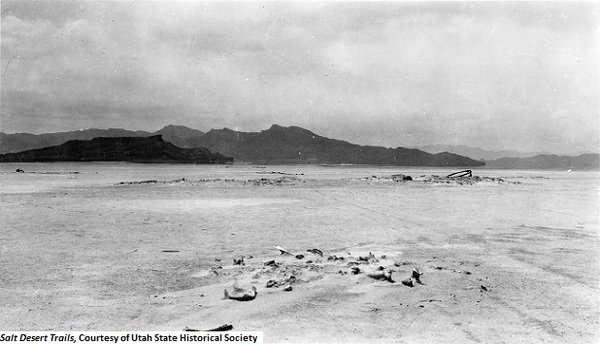Dublin Core
Title
Description
A site near present-day Grantsville provided temporary relief to the Donner party before their dangerous push across the Great Salt Lake Desert.
In 1846, a series of overland parties found relief at a site on the south end of the Great Salt Lake near present-day Grantsville known as Twenty Wells. The place got its name from a series of holes in the ground that were filled, according to overland emigrant and early historian Jessy Quinn Thornton, by water from underground springs. The holes, which to some looked like man-made wells, were so deep that a party of California-bound travelers intent on sounding their depths came up empty-handed despite using seventy-foot lines.
The first group of California-bound overlanders to rest at Twenty Wells appears to have been the Harlan and Young wagon company, which included the first Mormons to see the Salt Lake Valley a little less than a year before Brigham Young and his vanguard party of Latter-Day Saints drove into the Great Basin. The Harlan-Young Party had only recently buried one of their company—John Hargrave—in the vicinity of today’s Lake Point Junction, when they pulled into what is now Tooele Valley and found the cool, clear water of Twenty Wells. After a few days in the area, they picked themselves up and pushed across the Great Salt Lake Desert, finally reaching the Humboldt River in present-day Nevada in an exhausted state. Upon reaching the Sierra Nevada Mountains, they saw that snow was already covering the passes. Fortunately, they squeaked through to California by the skin of their teeth.
Nearly a month after the Harlan-Young company camped at Twenty Wells, the ill-fated Donner Party stopped at the same spot to recruit their animals and drink from the natural springs. Their story, of course, is much more tragic than that of the Harlan-Young emigrants. Like the earlier party, the Donner Company also had a hard time crossing the blazing desert west of the Great Salt Lake. But they were also torn apart by internal strife and difficulties along the Humboldt. When they reached the Sierra Nevadas, the snows had become heavier, effectively cutting them off from the California lowlands and leading some of them to turn to cannibalism in order to survive.
Creator
Source
Image: Salt Desert Trails, 1929. Remains of abandoned wagons from the Donner-Reed Party. Photographed by Charles Kelly. Courtesy of Utah State Historical Society.
_______________
See Charles Kelly, “The Hastings Cutoff,” Utah Historical Quarterly 3 (July 1930): 67-82; Dale L. Morgan, The Great Salt Lake (Albuquerque: University of New Mexico Press, 1947), 148-175; George R. Stewart, The California Trail (New York: McGraw-Hill, 1962), 142-184; George R. Stewart, Ordeal By Hunger: The Story of the Donner Party (Boston: Houghton Mifflin, 1988), 40-50; Charles Kelly, Salt Desert Trails (Salt Lake City: Western Epics, 1996), 49-114; Michael S. Durham, Desert Between the Mountains: Mormons, Miners, Padres, Mountain Men, and the Opening of the Great Basin, 1772-1869 (New York: Henry Holt and Company, 1997), 80-81; and Ouida Blanthorn, comp., A History of Tooele County (Salt Lake City: Utah State Historical Society, 1998), 45-61. Also see David Bigler’s entry on the Harlan-Young Party in the online Utah History Encyclopedia.

